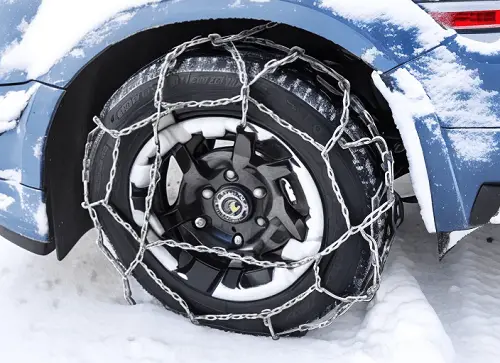How To Figure Out Size Of Tire Chains

Driving in winter weather can be a hazardous experience. Snow, ice, and slush on the roads can make it difficult for vehicles to maintain traction, increasing the risk of accidents.
One solution to this problem is using tire chains, which provide added traction by creating a more aggressive grip on the road surface. This article will explore the factors to consider when selecting tire chains, how to determine the appropriate size and tips for installation and maintenance.
Factors to Consider
When selecting tire chains, several factors must be considered to ensure that you choose the right size and Type of chains for your vehicle’s tires. These include:
Tire Size
Before purchasing tire chains, knowing your vehicle’s tire size is crucial. This information can typically be found on the sidewall of the tires or in the vehicle owner’s manual. The size will combine numbers and letters, such as P235/75R15. The tire size is essential because it determines the size and fit of the tire chains you’ll need to buy.
Type of Vehicle
Different vehicles have different requirements when it comes to tire chains. For example, some cars have low wheel well clearance, so you must use low-profile or S-Class chains. On the other hand, trucks and SUVs may require heavy-duty chains designed for larger tires and heavier loads.
Type of Tire Chains
Several types of tire chains are available, each with its own set of benefits and drawbacks. Some popular options include cable chains, ladder-style chains, and diamond-pattern chains.
Cable chains are lightweight and affordable but offer less traction than other types. Ladder-style chains provide excellent traction but may have a rougher ride. Diamond-pattern chains offer a balance of traction and ride comfort but tend to be more expensive.
Driving Conditions
Consider the specific driving conditions you expect to encounter when selecting tire chains. If you mostly drive on icy or packed snow, ladder-style chains may be the best option. For deep snow or slush, diamond-pattern chains can provide better traction.

Selecting Appropriate Size Of Tire Chains
To determine the appropriate size of tire chains, you should consider the following steps:
Manufacturer’s Recommendations
When selecting tire chains, always consult the vehicle manufacturer’s recommendations first. They may have specific requirements or restrictions based on the make and model of your vehicle.
Use online Tire Chain Sizing Tools
Many tire chain manufacturers offer online sizing tools that help you determine the correct size chains for your vehicle. Simply enter your tire size, and the tool will recommend a compatible product.
Consult With A Tire Specialist
If you’re unsure which tire chains to choose, consult a tire specialist at a local tire shop or automotive retailer. They can help you make the right decision based on your vehicle’s specifications and your driving needs.
How Much Are Tire Chains?
Tire chains are not overly expensive, with most sets costing between $30 and $60. However, choosing a quality set of chains that will last you for several winters is important. It’s also a good idea to buy a slightly larger set than your tires, as this will give you some extra room to adjust the chains if necessary.
How Many Tire Chains Do I Need?
You will need four tire chains for your vehicle, two for the front tires and two for the rear. Check your owner’s manual to see if your vehicle has any special requirements for tire chains. For example, some vehicles require the front and rear chains to be of different sizes.
How Fast Can You Drive With Tire Chains?
The recommended speed limit when driving with tire chains is typically around 30 miles per hour (48 kilometers per hour). Driving at higher speeds with tire chains can cause damage to the chains, your tires, or your vehicle and may also compromise your safety. Always follow the manufacturer’s recommendations and local regulations regarding tire chain usage and speed limits.
Are Tire Chains Worth It?
Tire chains can be worth it, depending on your specific circumstances and driving conditions. Here are some factors to consider when deciding if tire chains are a good investment for you:
- Location and weather conditions: If you live in an area with frequent heavy snowfall, icy roads, or extreme winter conditions, tire chains can provide additional traction and safety while driving. In these cases, tire chains are worth the investment.
- Local laws and regulations: Some regions require drivers to use tire chains during certain times of the year or in specific weather conditions. Check your local regulations to determine if you need tire chains to comply with the law.
- Type of vehicle: Tire chains are typically more beneficial for rear-wheel drive vehicles, which tend to have less traction in slippery conditions. Front-wheel and all-wheel drive vehicles may not require tire chains as urgently, but they can still provide additional safety.
- Frequency of use: If you rarely encounter snow or icy conditions, investing in tire chains may not be necessary. However, if you regularly drive in winter weather, tire chains can be a worthwhile investment.
- Alternative options: There are alternative traction devices, such as snow socks and studded tires, which can benefit tire chains similarly. Research these options and consider your specific needs and preferences to decide if tire chains or an alternative solution is best for you.
In summary, tire chains can be worth it if you frequently encounter severe winter driving conditions, have a vehicle that benefits from additional traction, or is required to use them by local regulations. Consider your specific circumstances and evaluate alternative options before making a decision.
Conclusion
Tire chains can be a valuable safety tool for drivers frequently encountering winter weather conditions. Understanding the factors to consider when selecting tire chains, determining the appropriate size, and properly installing
Maintaining them can significantly improve your vehicle’s traction and overall safety on icy and snowy roads. Always consult the manufacturer’s recommendations, and when in doubt, seek advice from a tire specialist to ensure you make the best choice for your vehicle and driving needs.

